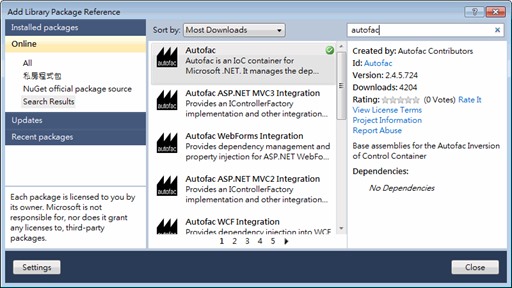Autofac筆記 1
| | | 0 | |
決定在專案引進IoC,端午假期在網路上划龍舟,做了些研究。忘性愈來愈大,故筆記不可少,就順便跟大家分享。(對於IoC,我仍在初學摸索階段,諸位先進如發現有誤入歧途之處,還請指正)
【IoC?】
IoC是什麼? DI又是什麼? 很多.NET領域的老師及同學已深入研究並有專文介紹,此處不再班門弄斧:
- 保哥的文章: Unity Application Block 與 ASP.NET MVC 學習資源整理
- 91的介紹: [Software Architecture]IoC and DI (Spring.NET) , [ASP.NET]重構之路系列v4 – 簡單使用interface之『你也會IoC』
- 黃忠成老師的Object Builder Application(Unity的前身)剖析: Inside ObjectBuilder Part1, Inside ObjectBuilder Part 2, Inside ObjectBuilder Part 3, Inside ObjectBuilder 范例
- 可抽換元件設計模式- IoC Pattern - Pete.NET- 點部落
- [Object-oriented] : 控制反轉- 昏睡領域- 點部落
【比較】
.NET可用的IoC Framework百家爭鳴,但弱水三千也只能飲一瓢,頭痛的抉選時刻來了。
- Ninject, StructureMap, Unity, Spring.NET, Windsor, Autofac的精簡比較
- Comparing .NET DI (IoC) Frameworks, Part 1
- Comparing .NET DI (IoC) Frameworks, Part 2
(作者結論傾向Autofac,註冊遞迴錯誤處理是一大原因。Ninject在當時的Build版本不穩、Unity輸在建構式選取'及Property注入,StructureMap少了遞迴錯誤處理及建構式選取,Spring.NET的學習曲線太陡,功能強大,但常會陷入一堆XML手工。) - Scott Hanselman列舉的IoC容器清單: List of .NET Dependency Injection Containers (IOC)
- 系列文章: IoC in .NET part 1: Autofac, IoC in .NET part2: StructureMap, IoC in .NET part 3: Ninject 2 beta, IoC in .NET part4: Spring.NET, IoC in .NET part 5: Using CastleWindsor container, IoC Containers in .NET part 6: Unity Container
- 對岸MVP的Autofac心得
看過一些分析後,我對Unity與Autofac比較感興趣。Unity是微軟主推的IoC解決方案,有很豐富的教學資源(甚至有教學影片)、Autofac的特色則在全力發揮C#語言的特性,許多地方沿襲了LINQ/Lambda風格,簡潔扼要,很合我的胃口。(例如: builder.RegisterAssemblyTypes(typeof(MyModel).Assembly).Where(t => t.Name.EndsWith(“Repository”).OnActivating(e => ((IRepository)e.Instance).Init()); ) 而Autofac的開發社群挺活躍的,愛好者也不少,看來是可以安心選用的工具。
對"簡潔語法"總是有說不出的著迷,一如過去對jQuery/LINQ的一見鍾情,這回決定以Autofac當成IoC Container的學習入口,若發現有什麼重大缺失再轉向也不遲。
【術語】
- Component: 要註冊到Container的類別,當其他Component需要某項Service時,Container會依需要建立Component。
- Service: Component所提供的功能,多半以Interface方式定義,Component會實作這些定義
- Autowiring: Container多半有能力自動找到Dependency Injection的注射點,例如: 比對建構式的參數型別,提供所需的Service。
- Transient Component: 與Singleton成對比,指每次Container被要求時都新建一個Instance提供服務。(各Framework用的名詞可能有出入)
- Automatic Registration: 找出組件或環境裡的Component,自動註冊。
- CommonServiceLocator: 把IoC Container再抽象化,呼叫時透過統一的介面取得服務,不必去管底層使用何種IoC Container(中文參考)。目前支援Castle Windsor, Spring.NET, Unity, StructureMap, Autofac, MEF, LinFu。不過,要求彈性就要付出代價,異中求同代表只能使用各Container都支援的功能,無法將特定Container的優勢發揮到極致,如果不需要切換Container,
【初體驗】
我讀的第一篇入門文章是CodeProject網站的一篇教學: http://www.codeproject.com/KB/architecture/di-with-autofac.aspx。它用一個備忘事項提醒的類別當範例,剛好涵蓋常見的基本用法,所以我也實地跟著做一回,順便加上自己的一些詮釋。
先設計一個備忘事項檢查器類別,建構時傳入備忘事項資料來源及通知服務,CheckNow()會檢查是否已有到期事項,若有,就呼叫通知服務送出通知。
using System; using System.Linq; using System.IO; namespace AutofacLab { //備忘事項類別 class Memo { public string Title;
public DateTime DueAt; }
#region 通知備忘事項 //產生通知動作的呼叫介面 interface IMemoDueNotifier { void MemoIsDue(Memo memo); }
//實作由TextWriter輸出的通知服務 class PrintingNotifier : IMemoDueNotifier { TextWriter _writer;
// 傳入TextWriter的建構式 public PrintingNotifier(TextWriter writer) { _writer = writer;
}
// 輸出通知訊息到TextWriter public void MemoIsDue(Memo memo)
{ _writer.WriteLine("Memo '{0}' is due!", memo.Title); }
}
#endregion #region 檢查備忘錄 class MemoChecker { IQueryable<Memo> _memos;
IMemoDueNotifier _notifier;
// 建立備忘錄檢查器,顯示到期待辦事項 public MemoChecker(IQueryable<Memo> memos, IMemoDueNotifier notifier) { _memos = memos;
_notifier = notifier;
}
// 依目前日期找出已到期項目 public void CheckNow()
{ var overdueMemos = _memos.Where(memo => memo.DueAt < DateTime.Now);
foreach (var memo in overdueMemos)
_notifier.MemoIsDue(memo);
}
}
#endregion }
接著,我們寫一段Console程式來呼叫它。
using System; using System.Collections.Generic; using System.Linq; namespace AutofacLab { class Program { //在記憶體中建立一個IQueryable<Memo>資料來源 static IQueryable<Memo> GenSomeMemos() { IQueryable<Memo> memos = new List<Memo>() { new Memo { Title = "Release Autofac 1.0",
DueAt = new DateTime(2007, 12, 14) }, new Memo { Title = "Write CodeProject Article",
DueAt = DateTime.Now },
new Memo { Title = "End of The World",
DueAt = new DateTime(2012, 12, 21) } }.AsQueryable();
return memos; }
static void Main(string[] args)
{ NoDI();
Console.WriteLine("Done! press any key to exit..."); Console.Read();
}
static void NoDI()
{ //傳統寫法,物件的產生是寫死的 MemoChecker chkr = new MemoChecker(GenSomeMemos(), new PrintingNotifier(Console.Out)); chkr.CheckNow();
}
}
}
建構MemoChecker的地方很簡單,用一個函數產生IQueryable<Memo>作為第一個參數,當場傳入Console.Out建立PrintingNotifier當成第二個參數,簡單明瞭。如果不考慮未來調整的彈性,沒什麼不好。
MemoChecker chkr = new MemoChecker(GenSomeMemos(), new PrintingNotifier(Console.Out)); chkr.CheckNow();
下一步,用VS2010在專案中用NuGet加入Autofac(沒錯,又是NuGet,大家有沒有開始覺得它很好用?):

接著改寫程式讓Autofac來管理物件的建構,我將說明加在註解裡,直接看程式:
using System; using System.Collections.Generic; using System.Linq; using System.Text; using Autofac; using System.IO; namespace AutofacLab { class Program { //在記憶體中建立一個IQueryable<Memo>資料來源 static IQueryable<Memo> GenSomeMemos() { //...略... }
static ContainerBuilder builder; static void Main(string[] args)
{ builder = new ContainerBuilder(); //註冊MemoChecker,建構式的參數也由Container產生 builder.Register(c => new MemoChecker( c.Resolve<IQueryable<Memo>>(),
c.Resolve<IMemoDueNotifier>())
);
//將PrintingNotifier註冊成IMemoDueNotifier的預設來源 builder.Register(c => new PrintingNotifier( c.Resolve<TextWriter>())).As<IMemoDueNotifier>();
IQueryable<Memo> memos = GenSomeMemos();
//直接註冊現有物件是很方便的玩法,在此註冊IQueryable<Memo>的Instance //當需要IQueryable<Memo>時,就會用它 builder.RegisterInstance(memos);
//Console.Out有實作IDisposable,但不應該由Container來終結 //所以要加上ExternallyOwned builder.RegisterInstance(Console.Out).As<TextWriter>().ExternallyOwned();
InAutofacWay();
Console.WriteLine("Done! press any key to exit..."); Console.Read();
}
static void InAutofacWay()
{ //使用using包住Container //當程式結束時Autofac會自動處理需要Dispose的物件 using (var container = builder.Build()) { container.Resolve<MemoChecker>().CheckNow();
}
}
}
}
在Main()裡,我們花了不少精力註冊介面、型別,在註冊時,連建構式參數都試圖不寫死,例如: new MemoChecker(c.Resolve<IQueryable<Memo>>(), c.Resolve(IMemoDueNotifier))、new PrintingNotifier(c.Resolve<TextWriter>()),意思是IQueryable<Memo>、IMemoDueNotifier、TextWriter要傳入什麼,都可以用Container全權決定,保留最大彈性。而呼叫程式只剩下container.Resolve<MemoChecker>().CheckNow(),沒用到任何建構式,也不用指定任何參數。
但,明明程式執行結果與NoDI()相同,為什麼要多寫了這麼多程式嗎? 如此大費周章只為了換來一個好處,未來要改變資料來源、換掉TextWriter的輸出對象、甚至改成MessageBox彈出訊息,InAutofacWay()的程式完全不用做任何更動。在這個例子裡,搞了大半天只為求不想修改InAutofacWay(),沒什麼了不起;但想像一下,如果是在一個龐大且複雜的系統中要將資料來源由查詢資料庫改成從讀檔案取資料,會影響系統中數百段用到資料查詢來源的程式碼,現在只需要調整builder.Register()就瞬間搞定,IoC Container的威力就顯現了。
另外還有一點很重要,在進行單元測試時,我們亦可透過IoC Container抽換非測試重點的相關元件,讓測試得以順利進行。例如: 檢查庫存方法CheckStock()原本需要一個IStockDataProvider從SQL資料庫取得存貨資料,但單元測試期間,資料庫根本連個影子都沒有,此時在IoC Container註冊測試用的假IStockDataProvider物件,模擬提供必要的資料。CheckStock()中的container.Resolve<IStockDataProvider>().GetInventory(…)就可自動建構測試用假物件,順利執行測試。
【抽換實驗】
再來,準備來玩一下抽換遊戲,驗證IoC Container的功效,確認我們多寫的程式碼不是寫心酸的。
實驗1
將TextWriter換成StreamWriter,輸出到yyyyMMdd.log。執行後可以在檔案中看到原本輸出到Console.Out的內容。
因採用附加文字內容的做法,StreamWriter每次使用完畢可Dispose(),故不用像Console.Out加註ExternallyOwned(),在using (var container = …) 結束後,StreamWriter就會被Dispose()。
//...省略... //很方便的做法,直接註冊一個IQueryable<Memo>的Instance //當需要IQueryable<Memo>時,就會用它 builder.RegisterInstance(memos);
//將內容附加在yyyyMMdd.log(註: 此處未考慮Multi-Threading問題) builder.Register<TextWriter>(c => new StreamWriter( string.Format("F:\\{0:yyyyMMdd}.log", DateTime.Today), true));
InAutofacWay();
//...省略... 實驗2
新增一個MsgBoxNotifier(專案要參考System.Windows.Form.dll)
class MsgBoxNotifier : IMemoDueNotifier { public void MemoIsDue(Memo memo)
{ System.Windows.Forms.MessageBox.Show(
string.Format("Memo '{0}' is due!", memo.Title)
);
}
}
接著註冊MsgBoxNotifier為預設通知服務,此時結果會以MessageBox方式呈現。
//...省略... builder.Register(c => new MemoChecker( c.Resolve<IQueryable<Memo>>(),
c.Resolve<IMemoDueNotifier>())
);
//將MsgBoxNotifier註冊成IMemoDueNotifier的預設來源 //這裡用AsImplementedInterfaces(),因MsgBoxNotifier實作了IMemoDueNotifier //等同於As<IMemoDueNotifier>() builder.Register(c => new MsgBoxNotifier()).AsImplementedInterfaces(); IQueryable<Memo> memos = GenSomeMemos();
//...省略... 在不更動InAutofacWay()半行程式的前提下,我們可以任意改變其串接的服務,這就是費心導入IoC Conatiner所追求的。
Autofac還有不少細節,後篇再續。
Comments
Be the first to post a comment